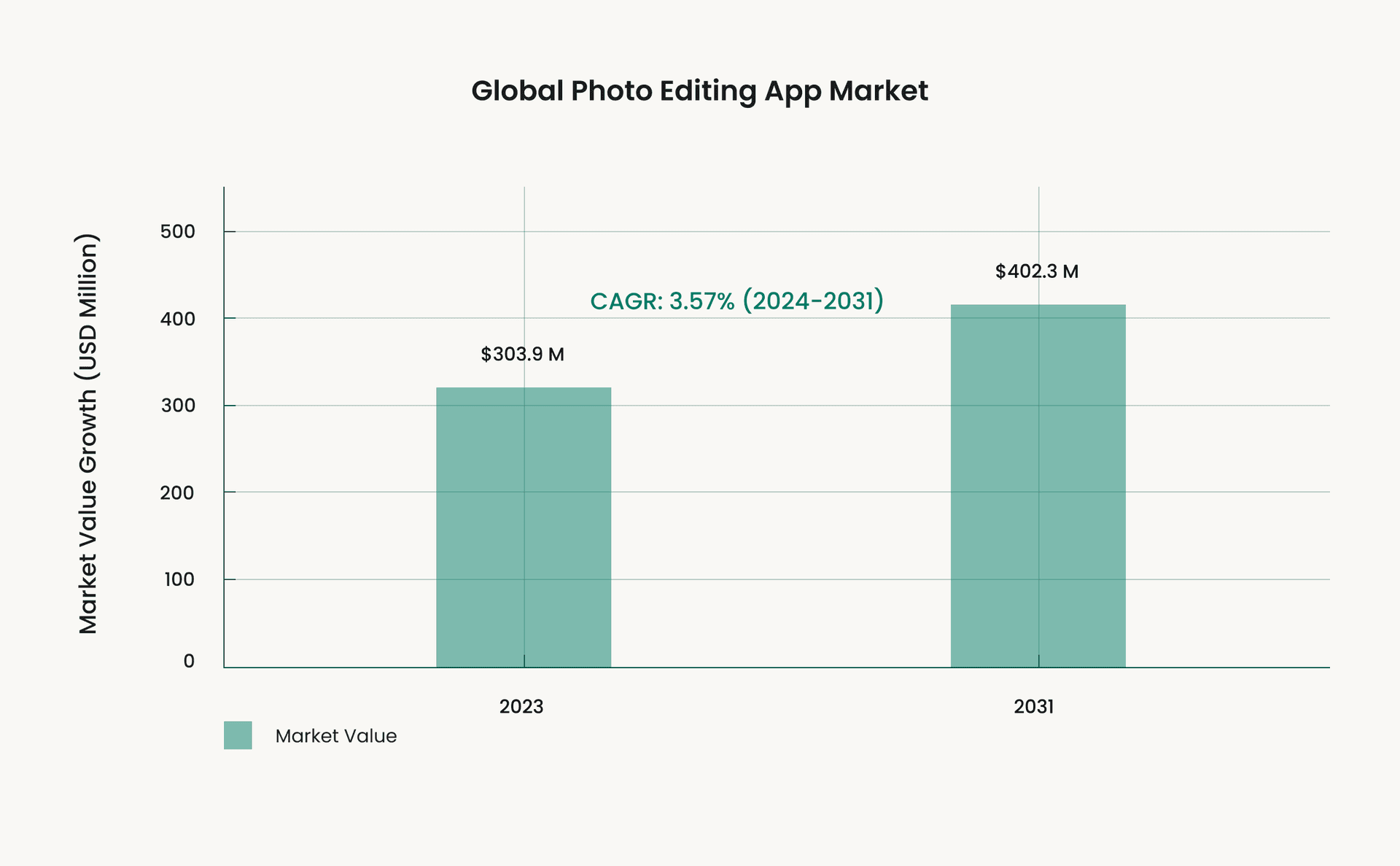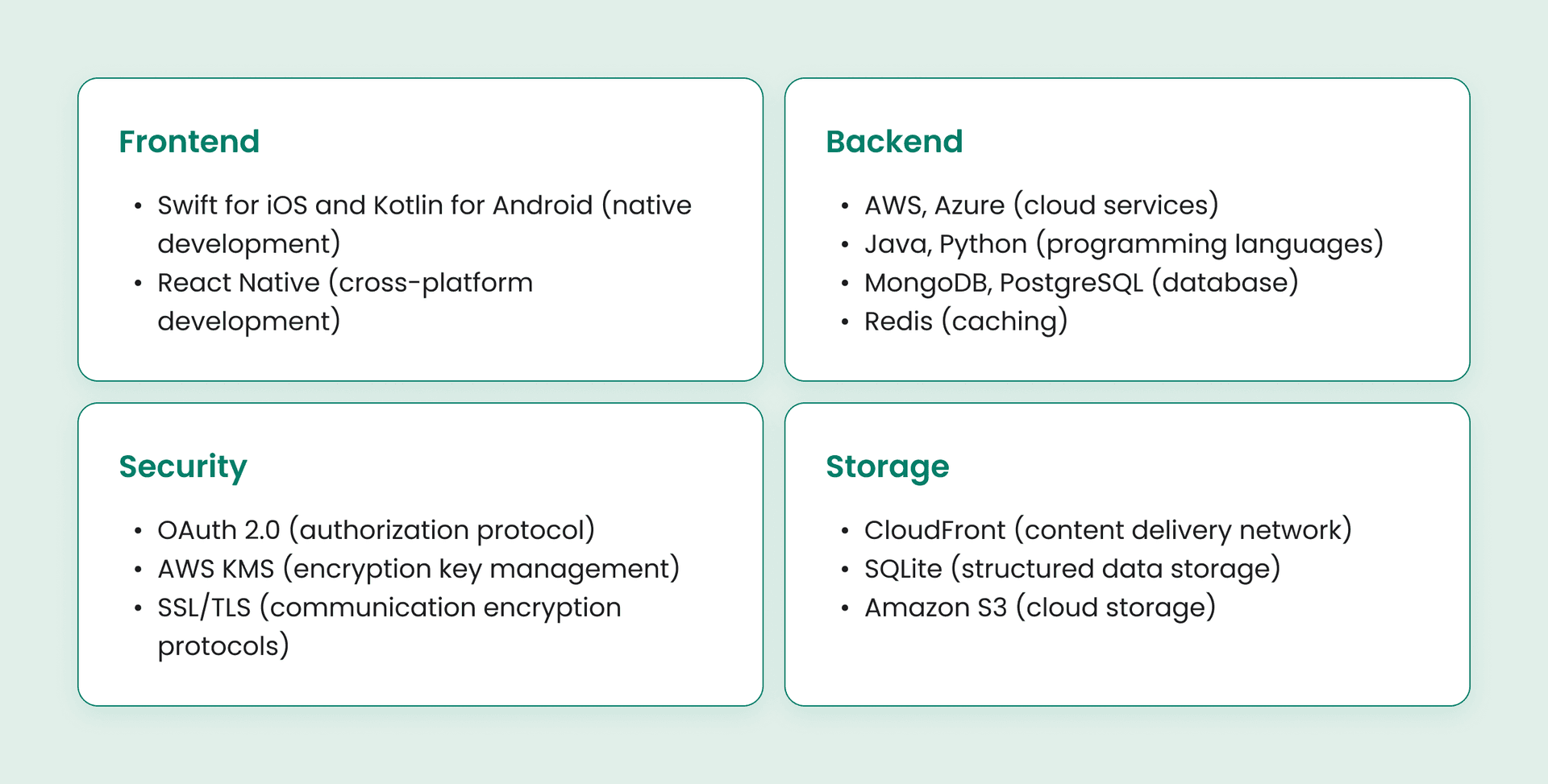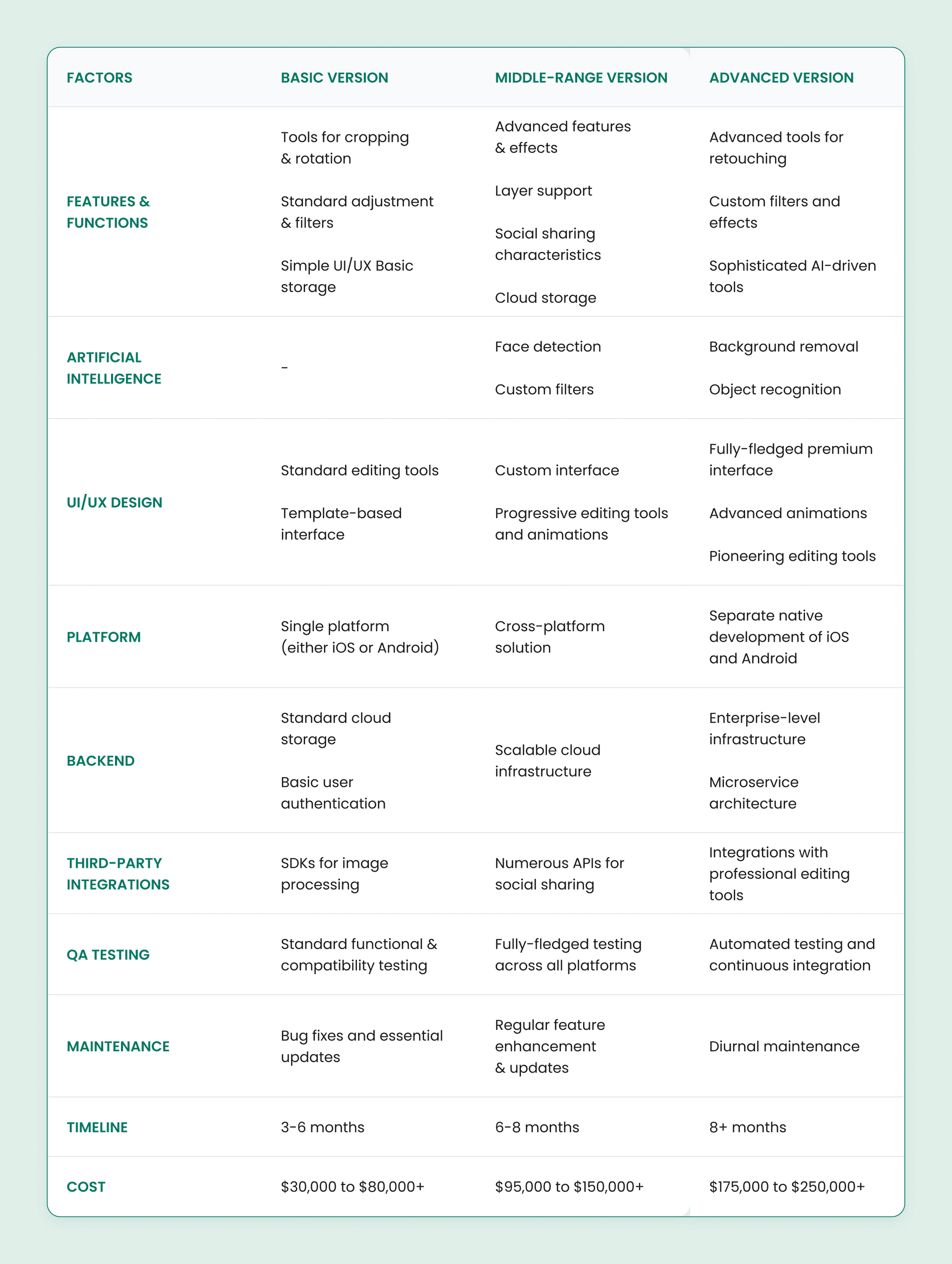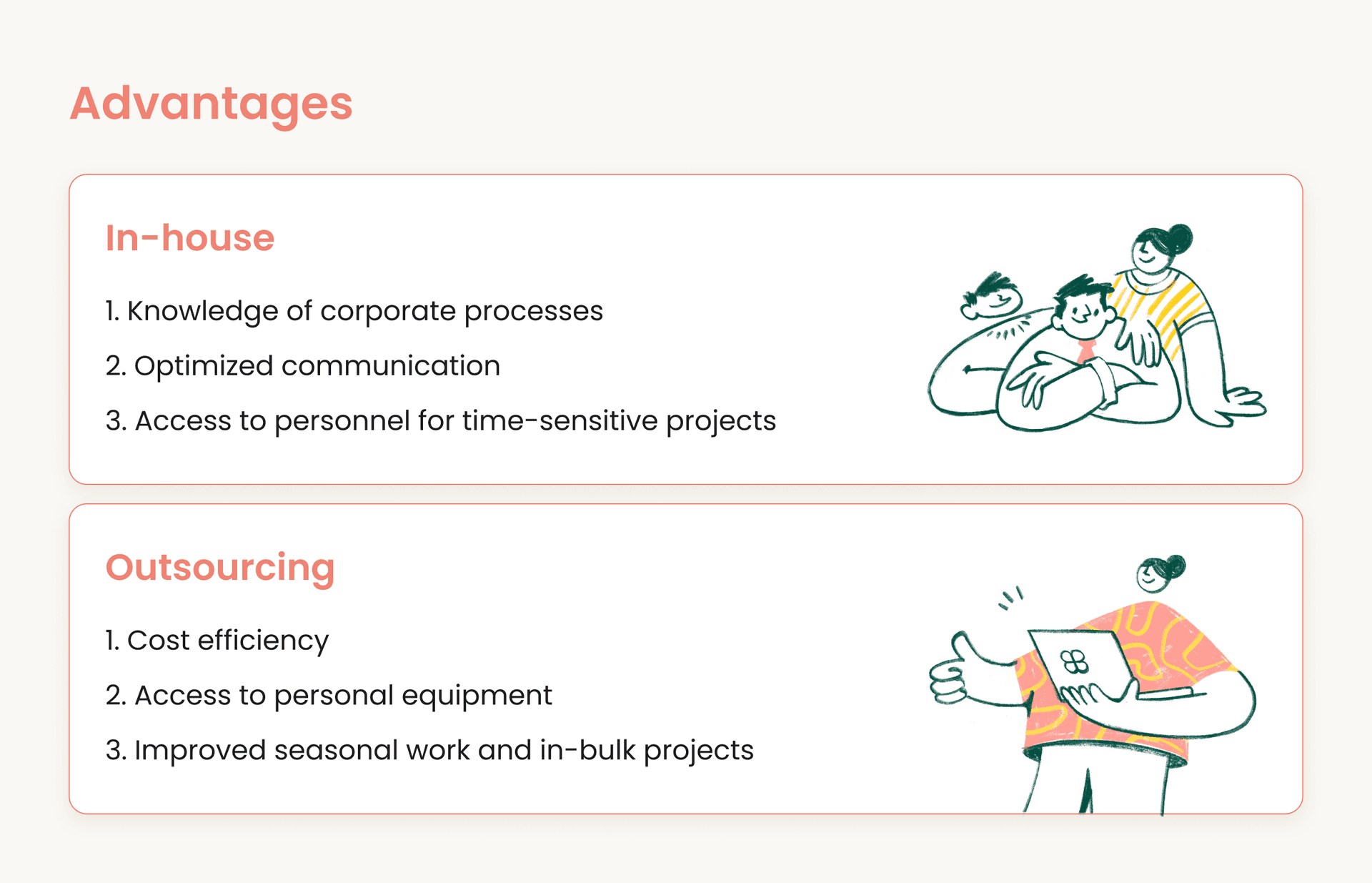Did you know North America owns over 40% of the global photo editing application market based on Credence Research? The statistics prove the overall market saturation regarding photography editing programs, making it a promising yet challenging segment to step in.
Feature selection, definition of the audience’s interests, and weak monetization strategy might lead the development of the software to a deadlock. To prevent this, we’ve analyzed how to build a photo editing app, including engineering costs, legal considerations, common mistakes, and how to avoid them.
Image Editing App Market Growth and Trends

According to Verified Market Research, the photo editing app market is anticipated to rise at 3.57% of CAGR from 2024 to 2032 and experience value growth up to $402.37 mil by 2031, compared to $303.92 mil in 2023.
The striking influence of social media platforms and intensified demand for high-quality visualization represent the principal causes of the growth in demand for image editing apps. Nevertheless, why are these applications so trendy among the end users? Let’s find out.
Artificial Intelligence
Artificial Intelligence is one of the dominating trends in photo editing, considering its multifaceted spectrum of opportunities, including content-aware fill, automatic image advancements, and smart object selection, which create a seamless and sophisticated user experience.
Filters
Filters represent one of the most essential proactive tools for meeting users’ specific photography needs, including portrait optimization, enhancing the quality of night/low-quality photos, and metamorphosing images with sophisticated artistic visualization elements.
Augmented Reality
Augmented Reality is a game-changer advancement in photo editing. With its real-time virtual try-ons, users can experiment with different styles and looks before making an actual image.
How to Make a Photo Editing App: 15 Steps
By modernizing conventional image-making with trendy, multifaceted functions, the image editing software attracts many multicultural users who have started viral trends on social media. Hereof, optimizing visual content becomes a profitable business opportunity, which raises the question of how to create a photo editing app.
Ideation
The first step of image editing platform development is envisioning the overall idea.
Market Research
The next essential development step is to define your target audience, their needs, and ways your photo editing application can fulfill those demands. Take into account demographic, situational, and psychographic TA analyses to get a comprehensive visualization of the ideal customer portrait.
The evaluated factors, such as gender ideation, income, lifestyle, interests and hobbies, usage patterns, time spent, location, and frequency of usage, can assist you in differentiating the target audience or motivate you to customize the application according to the needs of different users.
Competitor Analysis
Conduct a thorough competitor analysis to identify their application's core strengths and weaknesses, as well as evaluate the client's feedback to understand what they value the most in the software. The rival analysis will help you refine your Unique Value Proposition.
Idea Validation
Idea validation matters, as during this step, you have to check the overall viability of the idea prior to crafting the actual product. Conducting surveys and checking clients' feedback will assist you in determining the overall desirability of your future photo editing app.
Platform Selection
This stage requires you to consider the application you will engineer: native (iOS or Android) or the cross-platform variant.
Feature Set
During this stage, you must consider what basic editing tools and standard and/or advanced capabilities your application will comprise. It’s important to select elements that will align with your business needs and budget constraints.
Monetization Model
If you decide to make your photo editing app free to download and use, you can still earn extra revenue by selecting the monetization model that best suits your business. Two prominent examples are in-app advertisements and premium models. In the first case, you gain extra money by displaying ads and providing access to a limited number of premium features after watching the video advertisement. In the premium model, people pay for extra features based on monthly or yearly subscription plans.
Cost Estimation
The next step is to define the project scope and budget. Cost estimation is important in identifying the resources required for the photo editing app development, setting the relevant time frames, and deciding the number of IT specialists involved.
Team Setup
You need to either hire app developers and integrate them into your project or arrange tasks and set deadlines for your in-house team.
UI/UX Design
The UX/UI design phase will cover the representation of interface design concepts, user flow mapping, and accessibility matters. Additionally, this development phase will touch on creating wireframes and mockups.
MVP Development
MVP development is essential in building a photo editing application as it will focus on crafting the core elements to deliver the main product value with minimal financial input.
 Explore how businesses can reduce development costs with MVP.
Explore how businesses can reduce development costs with MVP.
App Development
The app development stage represents the practical crafting of the photo editing app features, design patterns, generating data flow logic, setting social sharing integrations, and cloud storage.
Testing
The post-development process requires embarking on multiple tests to check the correct functionality of each feature (unit testing), the effectiveness of the app’s work under key load (performance testing), the correctness of social media sharing, cloud synchronization (integration testing), etc.
Launch
When the testing procedures are complete, the application should be uploaded to App Market and Google Play to start its practical usage.
Updates & Support
The final step in building a photo app is collecting clients' feedback on their impressions, recommendations, and complaints to make further improvements. Additionally, post-launch maintenance involves continuous monitoring of the app’s functionality to back up its features and resolve tech bugs if they occur.
Key Features of a Picture Editing App
When it comes to practical image editing app development, it’s important to distinguish between the features that will be covered in MVP and the capabilities of the final version of the product.
Must-Have Features for MVP
MVP stands for developing a minimal functional product with the most essential features and functions to check its viability before the comprehensive investment. Here are the least of the features that the MVP will include:
-
Basic Image Adjustment
Brightness and contrast controls, adjustments on saturation and exposure, and crop/rotate functionality represent the basic image adjustment element the MVP will cover.
-
Standard Filtering System
This factor includes basic preset filters and adjustments for the color temperature.
-
Main Functions
MVP development will include crafting standard photo editing app functionalities, such as basic format support and capabilities for importing and exporting images.
-
Storage and Sharing
The MVP development stage will cover local photo saving and craft basic sharing capabilities.
Additionally, the developers will engineer the intuitive navigation system and logic for basic gesture support while keeping the minimalist app design.
Nice-to-Have Features
The nice-to-have elements refer to the sophisticated and advanced functions the photo editing platform can provide you with:
The basic features, functionalities, and elements include:
-
Crop & Rotate Function
This feature is applied to obtain the desirable compositional representation effortlessly.
-
Adjustments in Contrasts and Brightness
This feature benefits both professional photographers and basic users, as it allows them to set the desired quality saturation.
-
Preset Filters
Preset filters are photo-editing settings that can transform the image into the finished product.
-
Retouching
Retouching is critical for most photo editing applications as it can help conceal beauty-relevant elements. Additionally, retouching provides a cloning feature, enabling the user to clone some image elements without altering the composition.
-
Text Overlays
Texting is one of the basic functions of the standard photo editing application, as it allows inscriptions on any area of the image.
On the other hand, it’s crucial to uncover some of the sophisticated elements that can significantly boost user experience when using photo editing software.
-
AR Filters
Virtual before-and-after image taking may increase customer satisfaction and affect their decision-making. For instance, haircut try-ons might motivate users to get in real life.
-
AI-Driven Filters
Background deletion and intelligent retouching can elevate photo editing to a new level and add zest to the final product.
Tech Stack for Photo Editing Application Development
Tech stack selection is an essential moment in the overall development of a photo editing app, as it will directly affect the ultimate engineering price and reflect the overall effectiveness of its functionality.
The reasoning behind this is that if you choose cross-platform development, it will cost more than the single-selected native platform (either iOS or Android) based on the single code logic support. So, all the features will function correctly on iOS and Android but will experience scalability issues.
On the other hand, native app development will bring more UX/UI intuitiveness due to its single-code basis, which minimizes lag but requires separate application development.
Here is the list of tech stack components for the photo editing app

Let’s clarify how this tech stack is specifically applied to photo editing platforms.
Frontend
Frontend relates to the application user interface's speed, responsiveness, and efficiency.
-
Swift is a programming language for iOS that ensures direct access to the smartphone’s camera and provides a real-time rendering of the image preview.
-
Kotlin is a programming language applied for Android app development, which is responsible for image manipulation capabilities (native variant) and access to Android’s graphic libraries, etc.
-
Kotlin and Swift are utilized separately as the single code base covers functions, UI/UX elements relevant to either iOS or Android.
-
React Native is about code reusability, enabling simultaneous photo editing app development for both platforms. This frontend component integrates custom UI elements for editing tools and incorporation of the native image processing modules.
Backend
The backend is a crucial component of photo editing application engineering as it touches on user management optimization, image processing and storage.
-
Azure functions backup event-driven operation, while AWS S3 is applied to ensure the scalability of picture storage.
-
Java programming promotes strong API engineering, while Python applies to image processing algorithms.
-
MongoDB is a database that stores client metadata.
-
Postgre SQL is utilized to backup user management and structured data.
-
Redis is applied to cache frequently accessed images and ensure queue management for task processing.
Security
Security considerations matter for ensuring user authorization, personal data protection, etc.
-
OAuth 2.0 represents an industry-standard protocol to ensure the client’s safe authorization via the image editing software.
-
AWS KMS is a handled service that is applied to create and control encryption keys.
-
SSL/TLS promotes safe uploading and downloading of client photos and protects against data interception during transfer.
Storage
A well-thought-out storage architecture can handle the influx of photo processing without compromising the app’s functionality and scalability.
-
CloudFront ensures automatic image compression and optimization. Additionally, CloudFront is about fast image distribution as it acts as a content delivery network.
-
SQLite promotes data sync with cloud storage, as well as supports offline functionality, and stores photos locally.
-
Amazon S3 ensures versioning capabilities to track the history of image editing and provides scalable cloud storage to save both original and edited photos.
How Photo Editing Apps Make Money
Although many photo editing software programs are free to use, which increases demand and product recognition, you should not ignore the monetization opportunities to gain additional revenue. Interested in how much money can you make creating an app? Then, let’s clarify some core revenue generation models applicable in the photo editing application context.
Freemium with In-App Purchases
The freemium model intertwines the overall standard free photo editing app features and sophisticated paid content available after purchasing a premium subscription. This monetization model provides clients with free time-based trials during which the clients get access to a plethora of multifaceted filters and special capabilities. This option suits users who want to examine whether purchasing a set of premium features would be worthwhile. Also, freemium visualizes the preview of the premium-level element so that the user can understand the app's unique features. Once purchased, the client has permanent access to the premium characteristics.
Subscription Model
The presented monetization model involves users paying a recurring price for cutting-edge editing tools and sophisticated elements. The subscription model ensures a stable revenue flow by increasing overall user satisfaction and brand recognition.
Ad-Supported Models / Brand Sponsorships
Integrating advertisements in your photo editing application can be a favorable option to boost your revenue generation through clicks and impressions. Nevertheless, don’t ignore user experience and the correct ad placement to balance app functionality and advertisement popups.
Brand sponsorship is one of the comprehensive monetization models, as the placement of personalized thematic brand-relevant ads can boost the reputation and recognition of the involved stakeholders.
Selling Filters or Effect Packs
Lastly, you can stimulate revenue growth by selling custom filters and effect pack monetization models. Why is this model attractive? That’s due to the sophisticated and individualized artistic overlays, themed filter collection, and seasonal effect packs that you can distribute for a limited time or ensure a lower price for in-bulk purchases.
Revenue Breakdown: What We Can Learn from Top Photo Editing Applications
Although it’s crucial to be aware of the core monetization models, knowing the successful integration of those strategies is a must to prevent mistakes in selection. Here are two cases of an efficient use of monetization models:
VSCO
Designed for social media sharing, VSCO implements a subscription monetization model by providing its users with a full suite of photo editing tools on mobile and web, cloud synchronization, and unlimited recipes to help users recreate their favorite looks.
Lesson Learned:
VSCO’s subscription model is a correct choice of revenue strategy selection based on selecting the key target audience and resolving their need. With its pro-level subscription, the app enables Gen Z to reflect their authenticity with advanced editing tools, creative ‘community’ features, and unlimited variants to recreate their favorite looks.
Facetune
Facetune is a professional photo editor app that combines a few revenue models to maximize user convenience. The freemium model enables clients to use the basic elements for free. The option of in-app purchases is available for those who feel satisfied with the free app version but would like to diversify it with some sophisticated elements.
Lesson Learned:
The combination of the monetization models can be considered a revenue backup, as it enables analyzing which model brings more monetization and determining which specific tools, features, or elements were preferred. Additionally, don’t forget about the importance of constant updates and customer feedback, as the new AI-generated functions lead to controversial reflections from the TA.
How Much Does It Cost to Build a Photo Editing App?
So, how much does the overall photography editing app development cost? Here is a breakdown of the approximate price based on the platform's complexity level.

For instance, PicsArt is a cutting-edge toolset that enables users to reinvent their photos with sophisticated functions like AI-based background changing, sticker making, and collage crafting to get an imaginative work of art afterward.
The approximate cost of tailoring a photo editing application like PicsArt ranges from $30,000 to $40,000 when underlining its basic features like user authorization, photo & video uploading, rotating & cropping images, and downloading images after editing. The features relevant to AI integration will add to the final price based on the extent of the developmental complexity.
In-House vs. Outsourcing: Pros & Cons
Team selection is equally important to the overall photo editing application. You have to consider your budget constraints, business priorities, and timeframes to get a fully-fledged branded application.
So, let’s dig into two approaches to photo editing software development: in-house and outsourcing.

In-House Developers
The in-house developers represent those professionals hired exclusively to work in the company and elaborate only on its projects.
Advantages
-
An in-depth understanding of corporate branding and processes
An in-house developer demonstrates proficiency in understanding the slightest undertones of the corporate workflows, enabling their rapid submergence into the photo editing app engineering process.
-
Streamlined communication
The team’s on-site presence enables you to communicate, discuss, or underline any requests, alterations, and considerations that bring visionary clarity to product development.
-
Expedited access to the tech personnel for time-sensitive projects
The in-house team is about flexibility and transparency of task-switching, especially under unforeseen circumstances.
Disadvantages
Nonetheless, in-house development assumes a spectrum of the following challenges:
-
Substantial expenses
Keep in mind that the in-house team requires considerable financial input to cover salaries, equipment maintenance, and inter-company policies such as sick leaves, etc.
-
Fixed capacity
Frequently, in-charge personnel can request the developers to switch between assignments, which can lead to deadline compliance delays and affect product quality afterward.
-
Reglamented personnel availability
The in-house developers provide their services under the contracts, which declare their working hours.
Outsourcing
Outsourcing assumes a model of cooperation under which the business enterprise integrates outside specialists into its project.
Advantages
-
Cost efficiency
The outsourcing team runs on time and material and a fixed monthly payment model. The first model focuses on time and resources, allowing flexible billing cycles. The cost of payment in the model of fixed monthly fee encompasses salaries of professionals involved and overhead costs.
-
Access to personal equipment
The outsourcing specialists use their facilities, which can reduce your expenses as you don’t have to pay for equipment maintenance and licensing.
-
Optimization of seasonal work and in-bulk projects
By hiring an outsourcing team, you can easily select the number of professionals per each required project, avoiding the in-house team's flexibility constraints. Additionally, you can hire developers only for the on-demand seasonal work, which can significantly economize your budget.
Disadvantages
-
Project management concerns
The integration of outsourced specialists might bring some complexities in coordinating the overall development process.
That’s not the challenge for Agilie. For over 15 years, Agilie has crafted unique from-scratch solutions based on SDLC-relevant methodologies.
We engineer fully-fledged, sophisticated solutions within time-sensitive deadlines, focusing on the sprint approaches within Agile and Scrumban software development methodologies.
This enhances flexibility and convenience as the client can request to implement alterations at any development phase, which will be processed within the sprint request was made.
-
Long-term sustainability issues
Another challenge relates to knowledge retention problems when the teams alter, enhancing the dependency on external expertise.
Agilie ensures the fully-fledged software development process, including the post-product release maintenance, by proceeding with regular updates, as well as performing the whole application reengineering with custom solutions per the unique clients’ requests.
Top Mistakes to Avoid
When delivering the photography editing application, you may encounter a number of mistakes that can significantly impact its success.
Weak User Interface Design
The unintuitive navigation and complicated editing tools can cause usability inconveniences and discourage users from utilizing the application.
Solution:
Set minimalist design principles and integrate tutorials on utilizing specific filters of in-app components.
Feature Abundance
Saturating your application with the versatility of critical and subsidiary features might provoke app bloating by undermining functional correctness.
Solution:
Conduct frequent feature usage analyses to determine the preferred ones and remove the unnecessary elements. The main point is to remain and update those features that bring maximized value to the end user.
The Ineffective Monetization Model
Utilizing the unmatching or aggressive monetization model might distract users from welcoming your photo editing application.
Solution:
Conduct frequent user satisfaction monitoring, and you can consider starting with a balanced freemium model with a clear value proposition for the sophisticated premium features.
Poor Marketing Strategy
Insufficient user acquisition plan or weak visibility in the application stores may result in TAs' lack of awareness of your product, leading to poor app promotion.
Solution:
Integrate analytics-driven marketing campaigns and boost your social presence to reinforce brand visibility. Additionally, you can consider collaborating with influencers to get the audience's attention.
Legal Considerations
Finally, when considering photo editing application development, don’t ignore the essence of legal requirements your platform must comply with.
EULA
As a legal contract between a software supplier and an end user, an EULA or End User License Agreement can ensure your company with legal protection, increase user trust, defend property rights, and conserve revenue strategies based on:
-
A clear description of the app’s functions and features.
-
User rights and restrictions on content editing.
-
Licensing conditions.
-
Terms of use and account deactivation.
Copyright Considerations for Photo Editing Apps
You don’t have to ignore the copyright considerations regarding the image editing process in your future application. Pay scrutiny attention to the following protective measures:
-
App content copyright - protection of proprietary filters and elements.
-
User-generated content - detailed terms on ownership of the edited content, as well as rights/limitations on sharing images.
-
Third-party content defense - set mechanisms to prevent copyright infringement.
-
Legal considerations - ensure copyright registration for the proprietary features.
GDPR
GDPR, or General Data Protection Regulation, is a part of EU privacy law that requires photo editing app suppliers to ensure secure client data processing and maintain user rights management based on the following:
-
Clear privacy policy on data management
-
Procedures for data breach notifications
-
User rights to access, alter, and delete their data.
Summary
Photo editing application development is an idea worthy of consideration due to the range of opportunities it presents. Market expansion, the emergence of new technologies, such as AR and 3D editing capabilities, and social integration can assist in making your platform trendy and increasing its demand.
Nevertheless, the following limitations need to be addressed before engineering your application. Market saturation, user expectations, and technical constraints might need additional market research, competitor analysis, and revenue model reconsideration to make the photo-editing app attractive and tech-sophisticated.
 Interested in engineering your custom photo editing app? Contact us to coop.
Interested in engineering your custom photo editing app? Contact us to coop.
